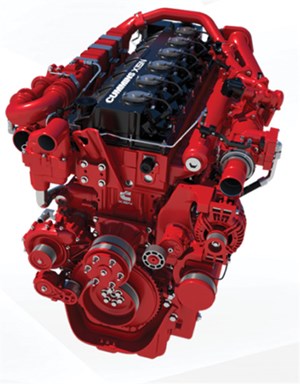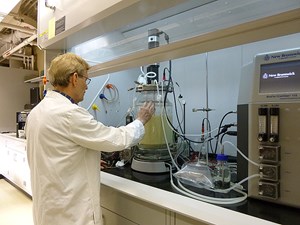Articles
H2Tech: Technology Spotlight
S. SHARMA, Technical Editor
TRANSPORTATION
ZeroAvia completes first high-power ground tests for a zero-emissions aviation power train system
After launching the development of its 600-kW powertrain for use in a 19-seat aircraft late last year, ZeroAvia has achieved its first major milestone for the HyFlyer II program. The ground test involved ZeroAvia’s flight-intent 600-kW powertrain pulling the company’s new 15-t HyperTruck mobile ground testing platform across the tarmac.
The HyperTruck, developed based on heavy-duty military trucks, is sized for the company’s ZA-2000 2-MW powertrain, which can be used to test systems for 40–80 seat H2-electric powered aircraft. The ground tests of the 600-kW propulsion system support the on-track development of the company’s HyFlyer II program, which will deliver a H2-electric, zero-emissions propulsion system for airframes 10–20 seats in size.
This is ZeroAvia’s first high-power run of the ZA-600, kicking off its test program for the flight-intent hardware to prepare the system for flight. The first milestone test flights of HyFlyer II’s Dornier 228 aircraft testbed are expected to take place later this year from ZeroAvia’s UK facility in Kemble.
Cummins’ H2 internal combustion engines to be tested in Werner’s fleet
Cummins and Werner Enterprises, a large U.S. freight hauling and logistics specialist, will begin validation and integration of Cummins’ announced 15-l (liter) natural gas and 15-l H2 internal combustion engines (ICEs) into Werner vehicles. Cummins will begin integrating these new powertrains in Werner trucks in the second half of this year, starting with the 15-l natural gas product.
Werner is a transportation leader focused on reducing its carbon footprint and Cummins is positioned to help provide low-carbon options successfully and seamlessly using multiple power solutions. Cummins’ solutions include the newest heavy-duty natural gas engine and the heavy-duty H2 ICE
engine under development.
The 15-l natural gas engine can be paired with a Cummins Eaton Automated Transmission Technologies’ Endurant HD transmission and Cummins fuel delivery system, which ensures a purpose-built and fully integrated natural gas powertrain. Other transmission pairings will be available at launch for specialized applications.
The 15-l natural gas engine will offer ratings up to 500 hp and 1,850 ft/lb of torque. It does not require selective catalytic reduction to meet 2024 California or U.S. Environmental Protection Agency emissions standards, providing a potentially carbon-negative solution when powered with renewable natural gas.
According to Cummins, H2 engines offer original equipment manufacturers and end users the benefit of adaptability by continuing to use familiar mechanical drivelines with vehicle and equipment integration. This mirrors current powertrains while continuing to provide the power and capability to meet application needs.
McPhy and HYPORT collaborate to decarbonize airport
McPhy will be a key partner of HYPORT to equip Toulouse-Blagnac airport with a complete zero-carbon H2 chain. The equipment will be comprised of two H2 stations set up in the immediate surroundings of the airport’s runways and roadways. A 400-kg/d electrolyzer, or the equivalent of 1 MW, will be deployed to supply the stations and the nearby industrial sites with green H2. To meet the airport area needs, a first station will be set up in a private restricted zone for airport services. The second station, equipped with dual-pressure configuration (two distribution pressures of 350 bar and 700 bar) will be deployed in a public zone and enable all types of vehicles (e.g., buses, light commercial vehicles, captive fleets, large goods vehicles) to be refueled with H2.
This complete zero-carbon H2 production and distribution solution will power nearly 200 vehicles, including a fleet of four buses operated by Transdev to transport passengers within the airport.
Beyond its pioneering nature, this project aims to support the deployment of H2 as a solution for the energy transition in the airport and aeronautical sector. Combining mobility, logistics and industrial uses, airports constitute real energy hubs, ideal for the development of H2-based ecosystems.
Energy Observer 2: A multipurpose cargo ship fueled by liquid H2
Energy Observer, after having developed an autonomous laboratory vessel with the first complete H2 chain, is now launching the design of a multipurpose cargo ship fueled by liquid H2. The technology will offer high transport capacity with great autonomy. With mature technologies in liquid H2 storage, deployment of liquefiers globally and mass-produced fuel cells, Energy Observer and its partners now focus on integrating large tanks and managing cryogenic temperatures. LMG Marin is the design office leading this project and Air Liquide is contributing to the project with its technological and innovation expertise. EODev is responsible for fuel cell integration in the ship while Ayro will equip the ship with its Oceanwings®. Bureau Veritas is accompanying Energy Observer as a key player in the field of maritime regulations and innovations.
The main features of Energy Observer 2 include:
- Length: 120 m
- Width: 22 m
- Draft: 5.5 m
- The surface of the wings: 1,450 m²
- Deadweight: 5,000 t
- Containers: 240 TEU (20 ft equivalent)
- Ro-Ro bridge: 480 linear m (trucks, vehicles and containers)
- Tween deck height: 6.5 m
- Access ramp: 15 m wide
- Commercial speed: 12 knots
- Electric propulsion: 4 MW
- Fuel cell power (RexH2 EODev): 2.5 MW
- Liquid H2 tanks (LH2): 70 t (1,000 m3)
- Range: Up to 4,000 nautical mi.
Fuel cell research partnership in heavy-duty transportation
Faurecia and MAN are partnering in a state-supported fuel cell research project. Faurecia will equip a Bavarian fleet (Bayernflotte) of heavy-duty trucks provided by MAN with complete H2 storage systems.
The project is backed with about €7 MM ($7.75 MM) in funding from the Bavarian Ministry of Economic Affairs, Regional Development and Energy. Faurecia, a part of Group FORVIA, will develop and seek certification for a new size of tank perfectly adapted to meet the requirements of heavy-duty vehicles and other applications with intensive use cases. This type of extra-large system can store an increased amount of H2, delivering a higher autonomy. This H2 storage system prototype will be developed in the R&D center in Augsburg, Germany.
Starting mid-2024, five selected end users will test these H2-powered fuel cell trucks in real-life operations for 1 yr, operating in the Bavarian region between Nuremberg and Munich.
Airbus and CFM pioneering H2 combustion system
Airbus has signed a partnership agreement with CFM International (CFM), a 50/50 joint company between GE and Safran Aircraft Engines, to collaborate on a H2 demonstration program that will take flight around 2025.
The program’s objective is to ground and flight test a direct combustion engine fueled by H2 in preparation for entry into service within a zero-emissions aircraft by 2035. The demonstration will use an A380 flying testbed equipped with liquid H2 tanks prepared at Airbus facilities in France and Germany. Airbus will also define the H2 propulsion system requirements, oversee flight testing and provide the A380 platform to test the H2 combustion engine in the cruise phase.
CFM will modify the combustor, fuel system and control system of a GE Passport turbofan to run on H2. The engine, which is assembled in the U.S., was selected for this program because of its physical size, advanced turbomachinery and fuel flow capability. It will be mounted along the rear fuselage of the flying testbed to allow engine emissions, including contrails, to be monitored separately from those of the engines powering the aircraft. CFM will execute an extensive ground test program ahead of the A380 flight test.
This significant step undertaken by Airbus in H2-powered flight is the next step after unveiling the ZEROe concept in late 2020 and leverages American and European expertise in engine manufacturing to make progress on H2 combustion technology. H2 combustion capability is one of the foundational technologies being developed and matured as part of the CFM RISE Program. CFM shares Airbus’ ambition of fulfilling the promise they made in signing the Air Transport Action Group goal in October 2021 to achieve aviation industry net-zero carbon emissions by 2050 by developing and testing the technology necessary to make zero-emissions aircraft a reality within the ambitious timeline defined.
POWER GENERATION
WEC Group testing H2 as fuel for power generation
WEC Energy Group is leading a pilot project to test H2 as a fuel source for power generation. The company will test co-firing H2 with natural gas at one of its power generation plants in Michigan’s Upper Peninsula (U.S.). This is one of the first H2 power pilot programs of its kind in the U.S.
WEC Energy Group has set some of the most aggressive environmental goals in the energy industry, including net-zero carbon emissions from electric generation by 2050 and net-zero methane emissions from natural gas distribution by the end of 2030.
WEC is assuming a lead role in testing H2 in modern natural gas-fueled generation units. According to WEC, as more renewable energy is brought online, it must be ensured the lights can be kept on when the sun is not shining and the wind is not blowing. The potential of adding H2 as a clean generating fuel to WEC’s fleet of dispatchable plants is an important bridge to a bright, sustainable future.
During the pilot project, H2 and natural gas will be mixed to a 25%/75% blend to power one of the generating units that serves customers of Upper Michigan Energy Resources, a WEC Energy Group subsidiary. The units use a technology known as RICE—reciprocating internal combustion engines. The engines were manufactured by technology company Wärtsilä.
WEC Energy Group is partnering with the Electric Power Research Institute, which will lead the technical implementation of the project and share results to further educate the energy industry about how to successfully use H2 for power generation to support reducing carbon emissions.
HYDROGEN PRODUCTION
Purdue Northwest’s process to turn food waste into sustainable H2 closer to licensing
The Purdue Research Foundation has completed a licensing agreement with an international energy company for the commercialization of a new process discovered at Purdue University Northwest (PNW) for the biological production of H2 from food waste.
This new process uses food waste to biologically produce H2 that can be used as a sustainable energy source for producing electricity, as well as for chemical and industrial processes or as a transportation fuel.
According to Robert Kramer, professor of Physics at PNW and principal investigator for the research, more than 30% of all food, amounting to $48 B, is wasted in the U.S. each year. That waste could be used in the developed process to create H2.
The research team has received five grants from the U.S. Department of Energy and the Purdue Research Foundation totaling approximately $800,000 over the last 8 yr to develop the science and technology that led to this process. Two patents have been issued for this effort and a third patent is in the final stages of approval. Over the next 9 mos, a scale-up test will be conducted. Based upon the results, it is anticipated that construction could start on the first commercial prototype within one year.
H2 is light, storable, transportable, energy-dense and produces no direct emissions of pollutants or greenhouse gases. Unlike fossil fuels, combustion of H2 does not produce carbon dioxide or oxides of nitrogen and sulfur. H2 also has a higher energy yield than hydrocarbons, according to the research team.
Currently, annual global H2 production is approximately 70 MMt, with natural gas as the primary source for this production. The process developed at Purdue uses what would otherwise be wasted food to produce H2 biologically.
TRANSPORTATION
H2 fuel cell to power line-rail haul
Progress Rail, a Caterpillar Inc. Co., BNSF Railway Company and Chevron, have entered an MoU to advance the demonstration of a locomotive powered by H2 fuel cells. The demonstration confirms the feasibility and performance of H2 fuel as a viable alternative to traditional fuels for line-haul rail. H2 has the potential to play a significant role as a lower-carbon alternative to diesel fuel for transportation, with H2 fuel cells becoming a means to reduce emissions.
Under the MoU, the parties are working toward reaching definitive agreements on a demonstration with three primary objectives. These include:
- Progress Rail plans to design and build a prototype H2 fuel cell locomotive for line-haul and/or other types of rail service.
- Chevron expects to develop the fueling concept and infrastructure to support the use of the locomotive.
- The prototype H2 fuel cell locomotive is expected to be demonstrated on BNSF’s lines for a mutually agreed upon period.
Progress Rail’s team will leverage Caterpillar’s advanced power technology knowledge and experience toward a H2 fuel cell locomotive, while working with Chevron and BNSF to advance H2 technology across the industry. Caterpillar Inc. is collaborating with Chevron for the demonstration of H2 projects in transportation and stationary power applications.
H2-electric propulsion nacelle for H2 aircraft design
H3 Dynamics has successfully completed the world’s first fully-integrated H2-electric propulsion aircraft nacelle, the core-enabling power solution for propulsion of future H2 aircraft designs.
In the future, a distributed H2-electric propulsion architecture could fly 19, 80 or even more than 100 passengers, allowing airlines to cover medium- and long-haul routes more than 2,500 km (1,553 m) beyond the short-haul flight distances targeted by emerging battery-based aircraft.
Instead of a single centralized H2 fuel cell system, H3 Dynamics distributes multiple integrated powertrains incorporating batteries, fuel cells, H2 storage and smaller electric motors across the wings. This means the size of each fuel cell system, hybrid battery pack and heat management challenges all become smaller, making systems more manageable and safer.
In 2018, H3 Dynamics filed international patents for full-scale distributed H2 propulsion and announced plans for “Element One,” a visionary H2 aircraft that applies this technology. The completion of the propulsion nacelle marks a key milestone for H3 Dynamics and the H2 aviation industry at large, which has gained much traction since.
According to H3 Dynamics, this is the world’s first working propulsion system capable of being distributed on the wings of new zero-emissions aircraft.
H3 Dynamics has been working in conjunction with the realities of safety certification timelines and entering the market with lower risk, reduced weight unmanned platforms, progressing step by step towards heavier cargo and manned platforms. The new H2 propulsion systems will begin flight tests in France.H2T






